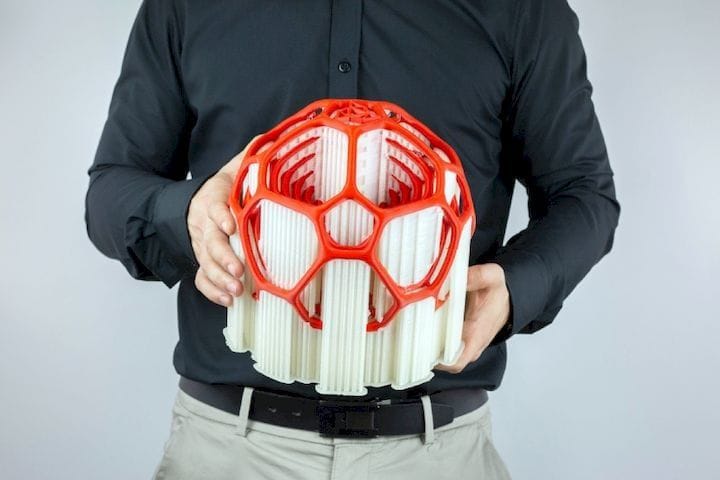![3DGence’s new high-temperature support material, ESM-10 [Source: 3DGence]](https://fabbaloo.com/wp-content/uploads/2020/05/image-asset_img_5eb0a0963280c.jpg)
3DGence announced a high-temperature dissolvable support material.
Support material is the bane of 3D printing, as it is a necessary evil to successfully 3D print many types of geometries. To use it you must consume more material, and add to your post-processing time, sometimes considerably.
One important development over the past two years has been the emergence of widespread use of soluble support material. This support material does not have to be manually picked off the print, which sometimes can damage delicate structures if support is attached.
Instead the raw 3D print is dunked in a liquid, usually water but sometimes other solvents, and the support material passively dissolves without human intervention. Sometimes there are specialized devices that circulate heated liquids to increase the speed of dissolving. But in any case, the 3D printer operator is free to do other work instead of spending potentially hours picking off solid support structures.
The most commonly used support material today is PVA, or polyvinyl alcohol. This material has revolutionized many 3D printing workshops through its ability to simplify operational workflows. It’s now commonly used in many professional dual-extruder 3D printing systems.
However, there’s a huge problem with this material: it has a glass transition temperature of 85C.
This is a big problem if you happen to be 3D printing high-temperature materials in a heated chamber that might be, say, 100C. If that’s the case and you were using PVA as your support material, you’d likely find the PVA drooping significantly and not really supporting anything.
Thus printing high-temperature materials can be a problem unless you have a support material that has a much higher glass transition point. And that’s just what Poland-based 3DGence announced.
![A PEEK 3D print using ESM-10 dissolvable support material [Source: 3DGence]](https://fabbaloo.com/wp-content/uploads/2020/05/image-asset_img_5eb0a0969de97.jpg)
Their new ESM-10 dissolvable support material is specifically designed for use in high-temperature environments. They say it can ensure the stability of prints “in a heated chamber above 80C”.
ESM-10 is best used in conjunction with 3DGence’s Support Dissolving System, a dedicated device that includes a circulating heated water reservoir. 3DGences explains that you must use a specific chemical solvent mixed with the circulating water to make the ESM-10 dissolve. However, they also say:
“The chemical solution together with the dissolved ESM-10 material can be safely discharged into the sewage system after rinsing.”
So it’s not just plain water used as the solvent here, as is done with PVA. However, that slight complexity is the price to obtain high-temperature dissolvable support material.
3DGence also says:
”ESM-10 does not recrystallize, which may cause dissolution of the material or failure of the hotends.”
![A spool of 3DGence’s new ESM-10 high-temperature soluble support material [Source: 3DGence]](https://fabbaloo.com/wp-content/uploads/2020/05/image-asset_img_5eb0a096e3e35.jpg)
This is interesting, as some materials tend to degrade, particularly PVA. This may not be the case with ESM-10, if I’m reading that correctly.
For those using high-temperature materials like PEEK, this material could be of great value.
Via 3DGence











An inventive designer has developed a method for producing 3D paper objects using recycled paper and 3D printed molds.